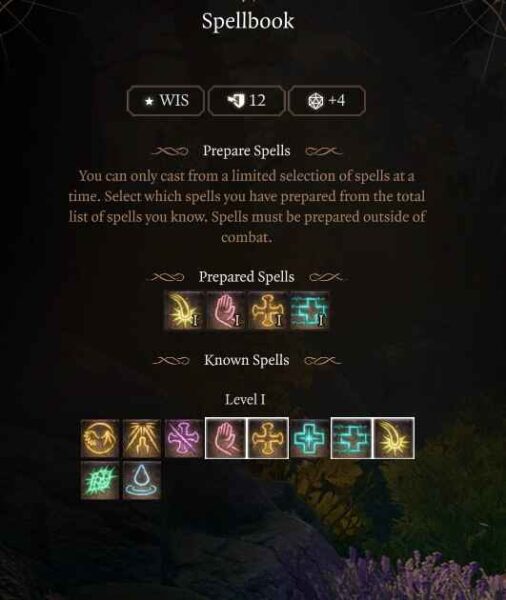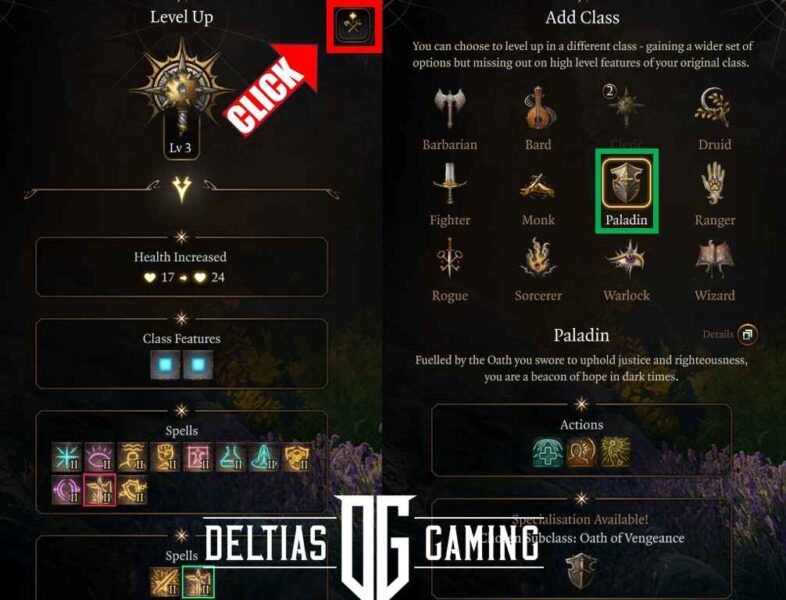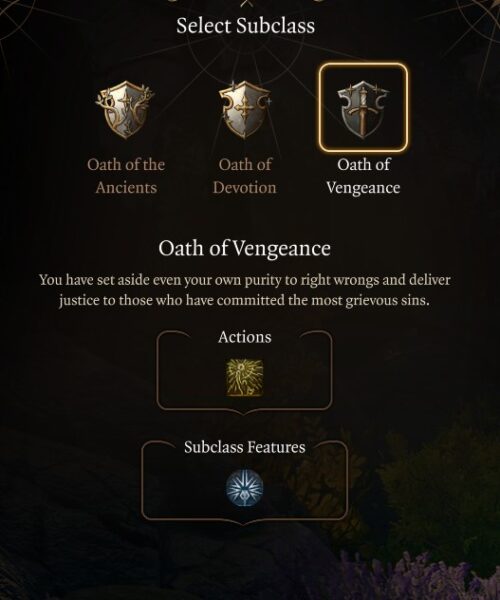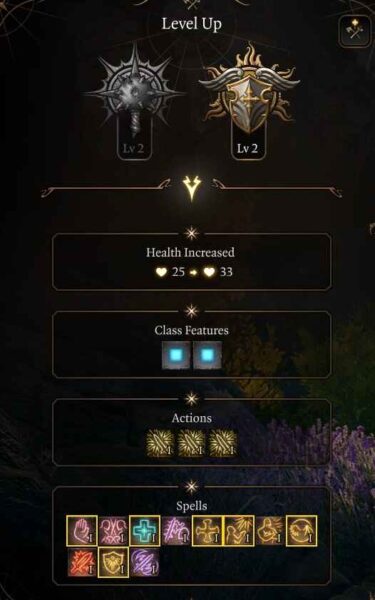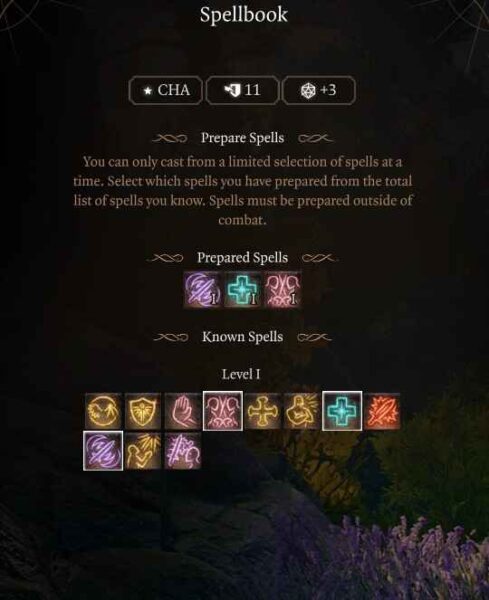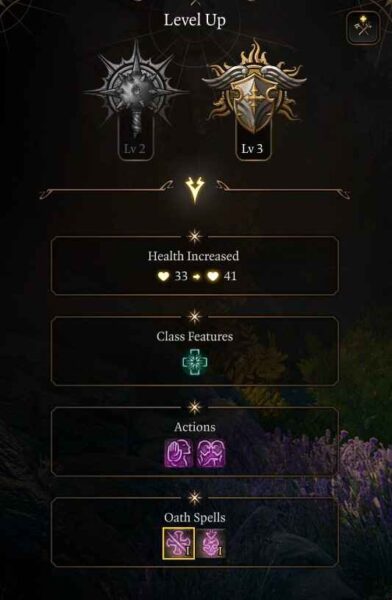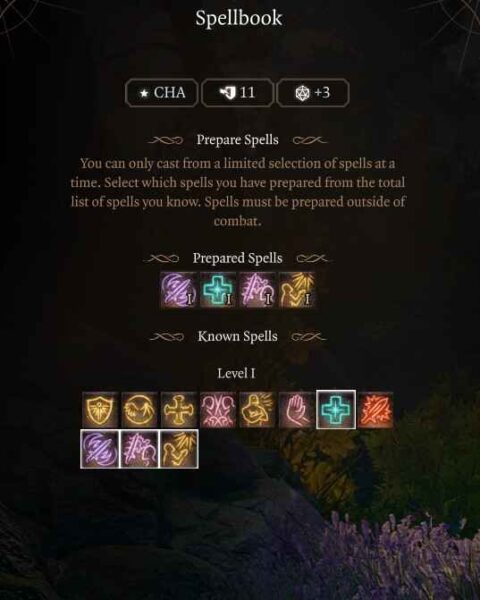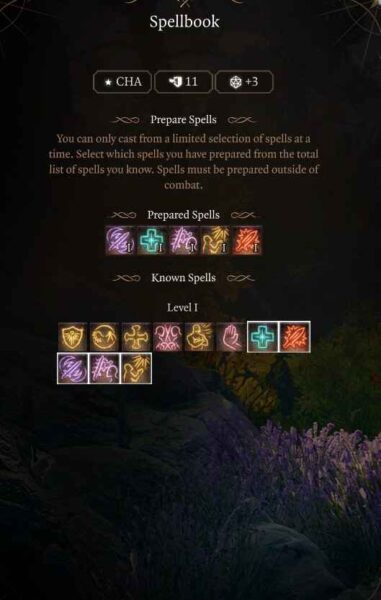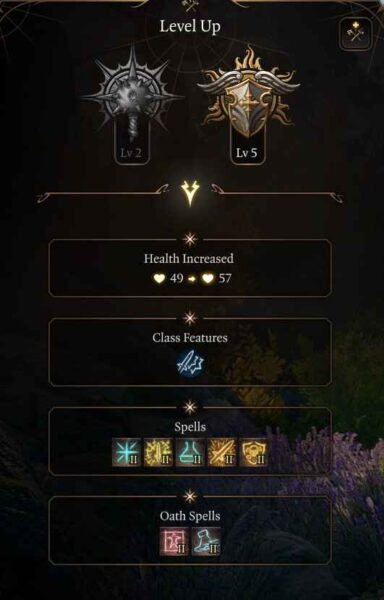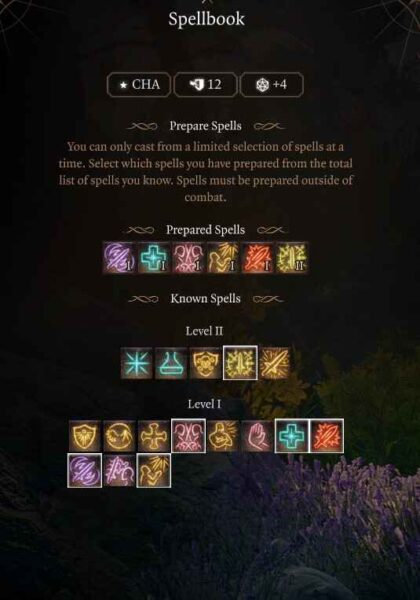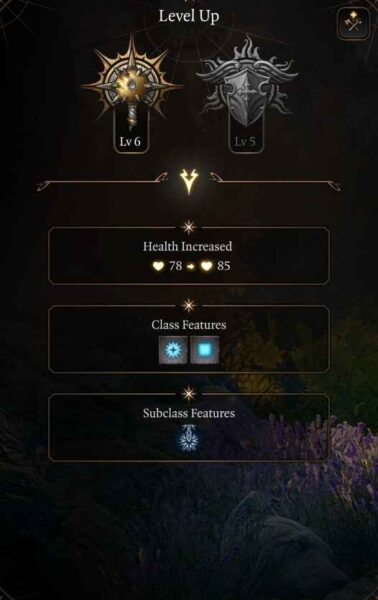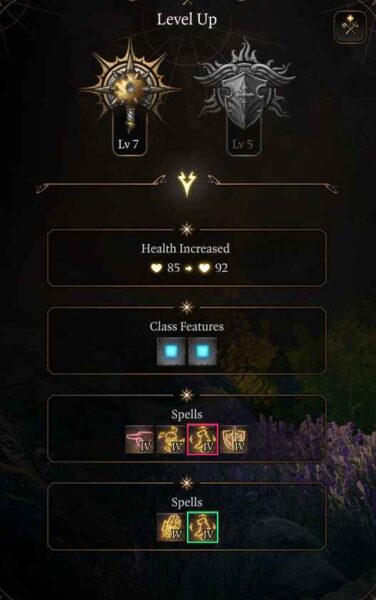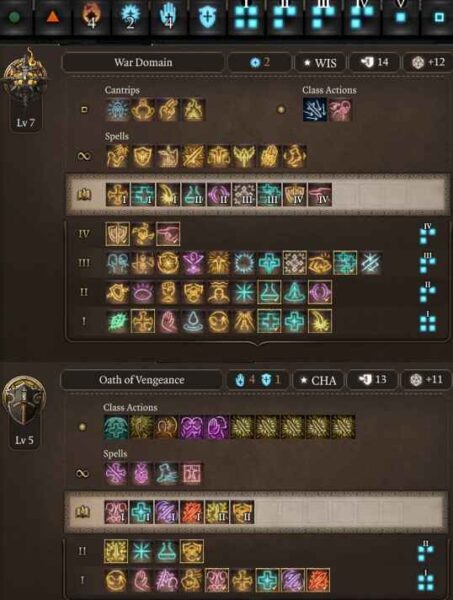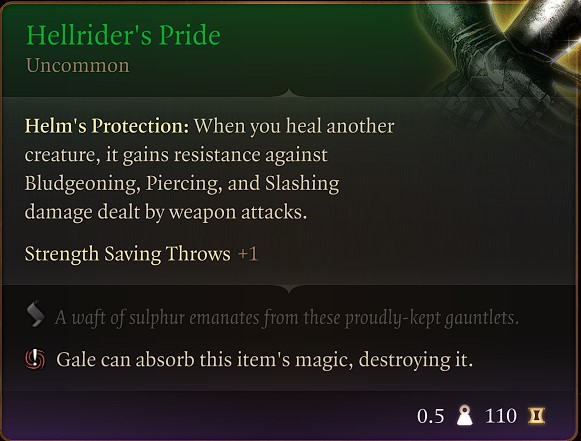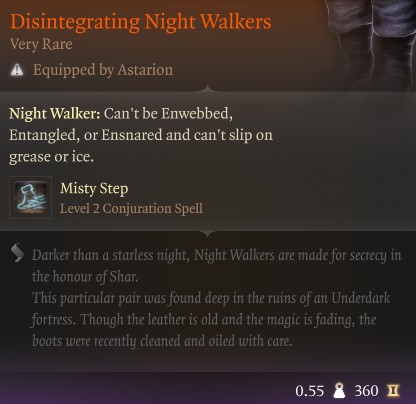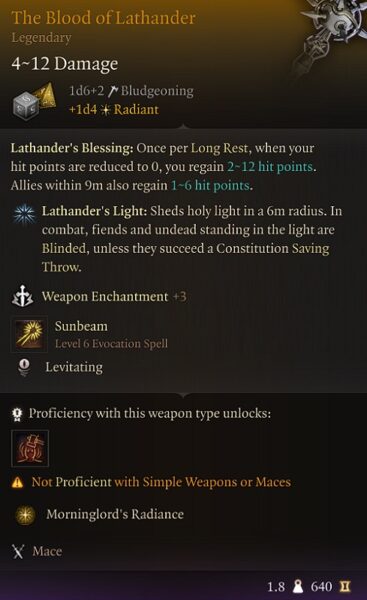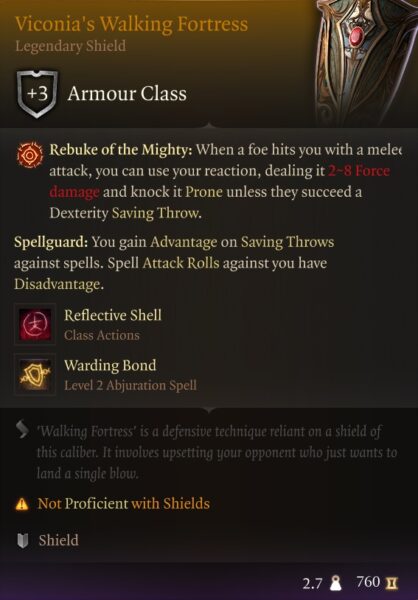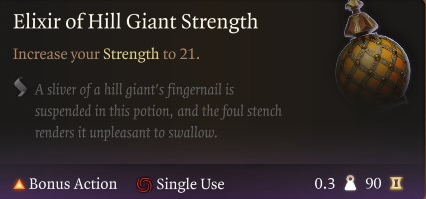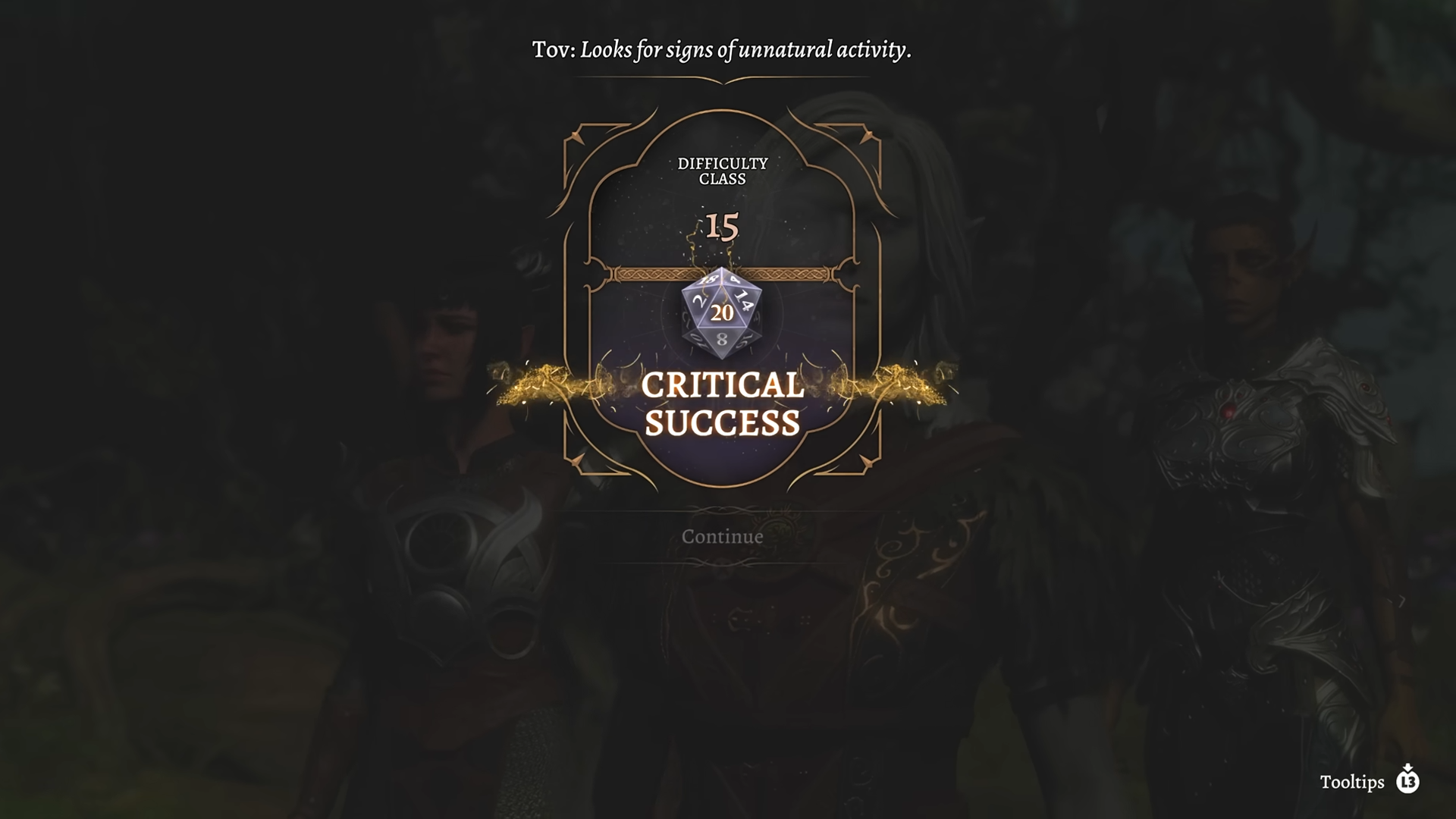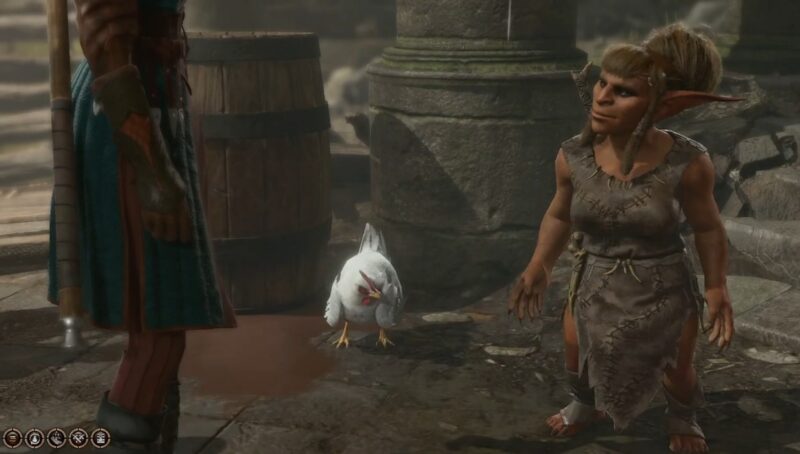This Multiclass guide focuses on the Multiclass Cleric in Baldur’s Gate 3 (BG3), combined with the Paladin class, to create a powerful build.

This build page has been updated for the Patch 8 version of Baldur’s Gate 3.
Everything About the Multiclass Cleric in Baldur’s Gate 3
The Cleric class in Baldur’s Gate 3 is a powerful spellcaster and versatile class that can excel in a variety of roles. Clerics have access to a wide range of spells, including both offensive and defensive spells, as well as support spells that can buff their allies and debuff their enemies. While Clerics are typically seen as support builds, this Cleric is an offensive, aggressive, hybrid melee damage dealer and spell caster.
This Cleric build uses multiclassing. Multiclassing means combining two classes the Cleric and the Paladin to further increase the build’s combat potential in BG3. The Cleric War subclass provides strong weapon damage features and skills, while the Paladin adds extra damage with Divine Smite and Extra Attack. These two classes combined create something special, though it can be complex with many spells and mechanics. This guide will walk you through creating the Best Baldur’s Gate 3 Multiclass Cleric Build Guide.
Multiclass Cleric Build Changes in Patch 8 for BG3

With Patch 8, Baldur’s Gate 3 introduces the Booming Blade cantrip for Clerics, a significant addition that empowers melee-oriented builds with a potent mix of magic and martial prowess. When cast, Booming Blade deals initial melee damage, then punishes enemy movement with a secondary burst of force. This makes it an excellent choice for Clerics who prefer to hold the front line and control enemy positioning through threat of retaliation.
For players seeking a resilient Cleric build that doesn’t sacrifice offensive capability, however, the Light Domain emerges as a strong contender. With access to powerful area-of-effect spells and excellent crowd control, Light Clerics offer a more defensive, balanced approach while still dishing out considerable radiant damage. In our Alternative Build below we will provide this other option for a multiclass build that focuses more on a tank role.
Multiclass Cleric Build Features
The following list presents all the essential Multiclass Cleric/Paladin Build Mechanics and Features in Baldur’s Gate 3:
- Primary Ability: Wisdom
- Saving Throws: Wisdom and Charisma
- Deity: Tempus
- Armour Proficiency: Light, Medium, Heavy, and Shields
- Weapon Proficiency: Simple Weapons, Martial Weapons
- War Subclass: specialized in striking with weapons, dealing physical damage.
- Guided Strike: Gain a +10 bonus to your Attack Roll.
- War God’s Blessing: Endow a nearby ally with the glory of your god to grant them a +10 bonus to their Attack Roll.
- Divine Strike: Once per turn deal 1-8 in addition to your melee weapon damage.
- Oath of Vengeance Subclass: subclass focused on damage and mobility.
- Channeled Oath Charges: Paladin-specific resource that allows the casting of spells and abilities.
- Divine Smite: Expend spell slots to deal additional radiant damage on a successful melee attack.
- Inquisitor’s Might: You or an ally’s weapon attacks deal additional Radiant damage equal to your charisma modifier.
- Abjure Enemy: Frighten an enemy, Fiends and undead have Disadvantage on this Saving Throw.
- Vow of Enmity: Gain Advantage on Attack Rolls against an enemy.
Multiclassing Explained
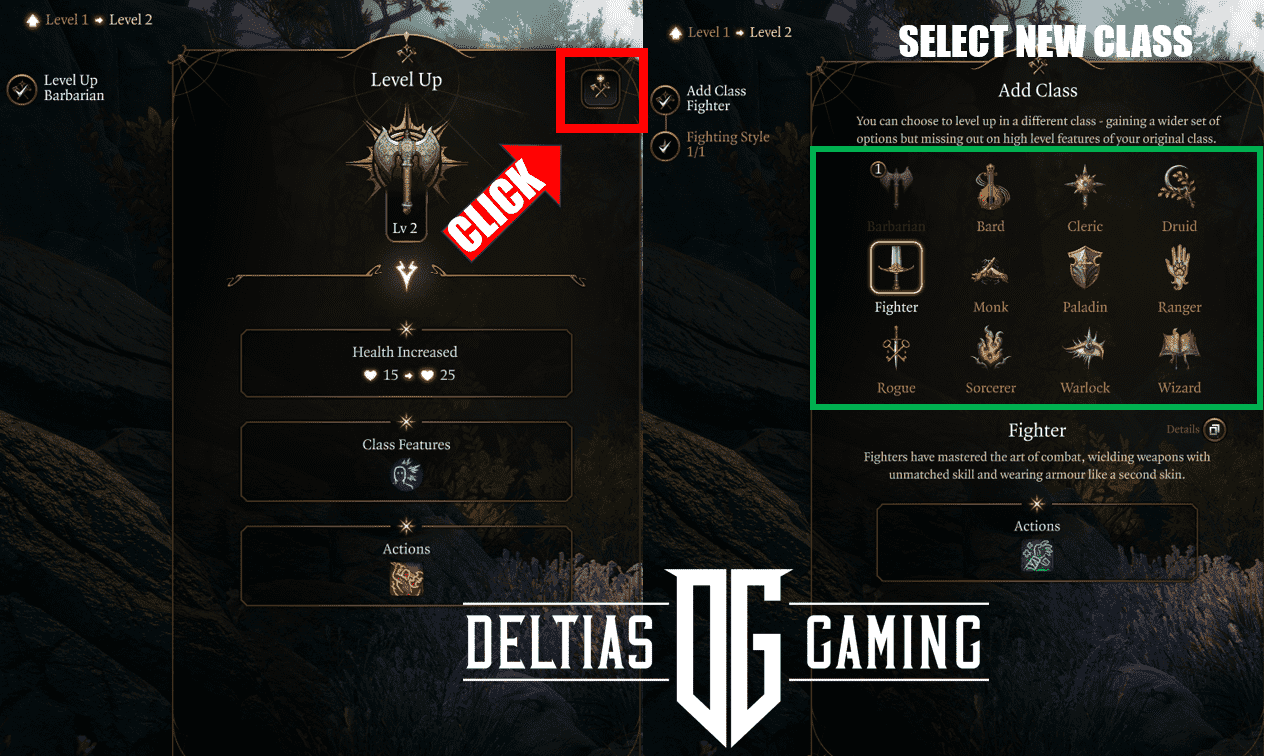
Multiclassing in Baldur’s Gate 3 allows your character to gain a level in a new class instead of advancing in their current class. To Multiclass in BG3, hit the top right plus button to add a class, so that it will bring up a new screen with the other classes in Baldur’s Gate 3.
Multiclassing grants most of the benefits of that new class, but there are some limitations. Your multiclassing character does not receive all the proficiencies of their new class. You also cannot multiclass when playing on Explorer Difficult.
Below is a list of Multiclass Proficiencies gained by taking one level in a new class:
| Class | Gained Proficiency |
|---|---|
| Barbarian | Shields, Simple Weapons, Martial Weapons |
| Bard | Light Armor, One skill, One instrument |
| Cleric | Light Armor, Medium Armor, Shields, Morningstars |
| Druid | Light Armor, Medium Armor, Shields |
| Fighter | Light Armor, Medium Armor, Shields, Simple Weapons, Martial Weapons |
| Monk | Simple Weapons, Shortswords |
| Paladin | Light Armor, Medium Armor, Shields, Simple Weapons, Martial Weapons |
| Ranger | Light Armor, Medium Armor, Shields, Simple Weapons, Martial Weapons, One skill |
| Rogue | Light Armor, One skill |
| Sorcerer | – |
| Warlock | Light armor, Simple Weapons |
| Wizard | – |
Best Cleric Multiclass
The best class for the Cleric to multiclass into is the Paladin because you can get Divine Smite, Extra Attack, and a Fighting Style. A secondary multiclass choice for Cleric is the Sorcerer because you get Metamagic, increased hit points, and elemental resistance of your choosing.
Here is the best multiclass choice for a Cleric build in Baldur’s Gate 3:
| Paladin | Sorcerer |
|---|---|
| Divine Smite | Metamagic |
| Extra Attack | Increased Hit Points |
| Fighting Style | Elemental Resistance |
For this build, we recommend 7 levels of investment into the Cleric and 5 into the Paladin. You get access to both class subclasses, two feats, and high-level spells. The Vengeance Paladin will add burst damage with Divine Smite and higher mobility with Misty Step. The War Cleric has access to War Priest allowing you to attack with a bonus action.
The two-class and subclass combination gives you a powerful melee martial class with heavy armour, one hand, and a shield with high-level spells. Consider this a strong hybrid spell caster with strong melee damage and group utility. This build will not be a traditional support Cleric, for that, we suggest Life Cleric for those players. Below we walk you through all the important selections in the leveling progression portion of the Best Baldur’s Gate 3 Multiclass Cleric Build.
Character Creation
| Category | Selection |
|---|---|
| Character | Origin – Custom character |
| Race | Zariel Tiefling |
| Racial Bonus | Smite Spells, Darkvision, and Fire Resistance |
| Class | Cleric/Paladin |
| Subclass | War/Vengeance |
| Cantrips | Sacred Flame, Guidance, Thaumaturgy |
| Spells | Guiding Bolt, Bless, Command, Sanctuary |
| Background | Folk Hero |
| Ability Score | STR: 16 DEX: 10 CON: 14 INT: 8 WIS: 16 CHA: 10 |
| Skill Proficiencies | Medicine and Persuasion |
Best Race
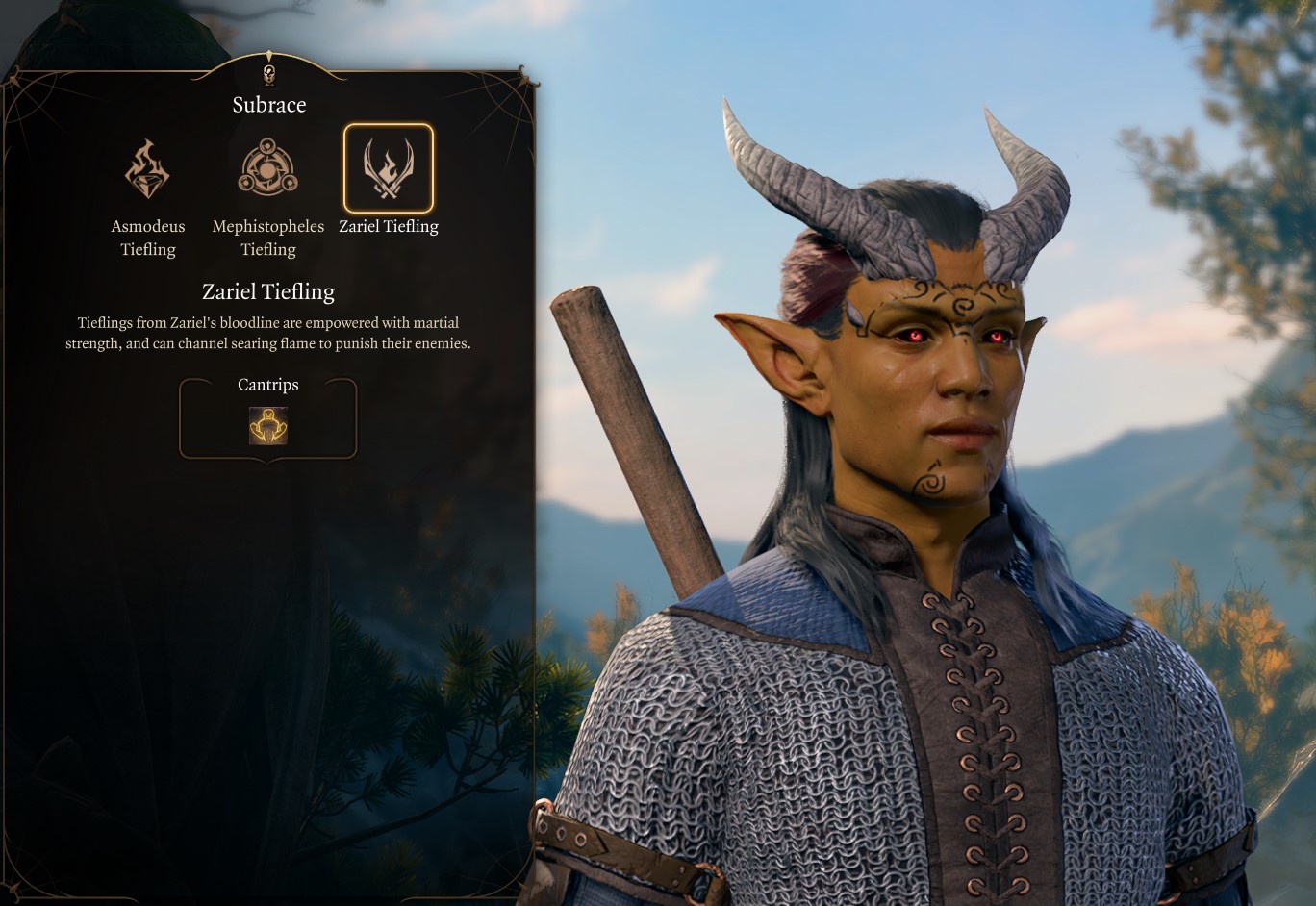
Zariel Tiefling is the Best Race Choice for a multiclass Cleric Build because you gain two Smite Spells, Darkvision, and Fire Resistance giving you powerful offensive and defensive capabilities. However, a secondary choice is the Githyanki because of their inherent mobility skills and spells, as well as skill proficiency.
Here is the best race choice for a multiclass Cleric build in Baldur’s Gate 3:
Recommended Background

The best Background for a Cleric Multiclass Build is Folk Hero because it has proficiency in two Wisdom-based skills. Backgrounds in Baldur’s Gate 3 are a way to represent your character’s backstory and give them some starting skills and abilities.
Best Ability Score

The Best Ability Score for multiclass Cleric Build is 16 Strength, 16 Wisdom, and 14 Constitution. This will give you a good blend of damage with melee attacks, health pool, and spell-casting capabilities.
Below is the best ability score for a multiclass Cleric in Baldur’s Gate 3:
- Strength – 16
- Dexterity – 10
- Constitution – 14
- Intelligence – 8
- Wisdom – 16
- Charisma – 10
For this build, the most critical ability score is 16 Strength for increased weapon damage. The rest of the selections are a bit more complex. Constitution determines health and concentration-based saving throws. Wisdom will influence your Cleric spells and Charisma will influence your Paladins spells.
Dexterity and Intelligence are the two lowest since they won’t be used to influence our damage. While Charisma influences Paladin spells, we won’t use high Charisma because of Divine Smite. Divine Smite is unique in that the damage isn’t affected by stats or ability scores. Thus, it’s not important to have high Charisma to influence our melee weapon burst damage.
Recommended Skills
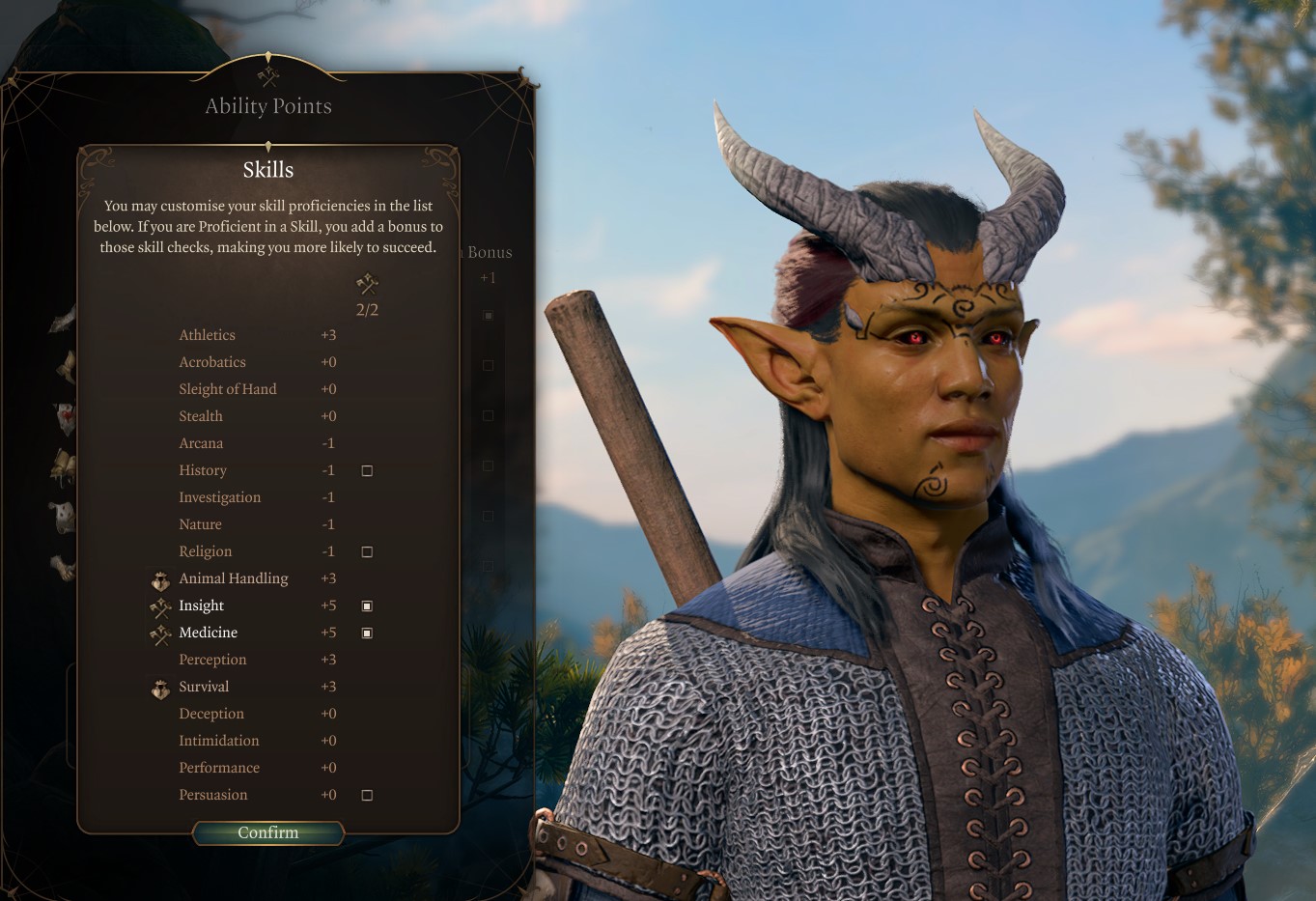
Medicine and Persuasion are the best skills for the multiclass Cleric because they complement your build when exploring the environment.
Companions
The best companions for a Cleric Multiclass build in BG3 are Halsin, Gale, and Astarion This will give you a balanced team with a Druid for support, a Wizard for area damage, and a Rogue for ranged damage, and utility.
- Halsin (Druid): crowd control, off-healing, and support.
- Gale (Wizard): range magic damage, area damage, and crowd control.
- Astarion (Rogue): range damage, lockpicking, and utility.
Related:
Multiclass Cleric Build – Level Progression in Baldur’s Gate 3
| Level | Class | Selection |
|---|---|---|
| 1 | Cleric | Sacred Flame, Guidance, Thaumaturgy, Guiding Bolt, Bless, Command, Sanctuary |
| 2 | Cleric | Healing Word, Turn Undead, Guided Strike |
| 3 | Paladin | Sublcass: Oath of Vengeance, Lay on Hands, Divine Sense, Inquisitor’s Might |
| 4 | Paladin | Protection Fighting Style, Divine Smite, Thunderous Smite , Cure Wounds, Compelled Duel |
| 5 | Paladin | Divine Favour, Bane, Hunter’s Mark, Abjure Enemy |
| 6 | Paladin | Feat: Savage Attacker, Searing Smite |
| 7 | Paladin | Extra Attack, Hold Person, Misty Step, Branding Smite |
| 8 | Cleric | Lesser Restoration, Magic Weapon, Spiritual Weapon |
| 9 | Cleric | Feat: Ability Improvement Strength, Light, Silence |
| 10 | Cleric | Mass Healing Word, Spirit Guardians, Crusader’s Mantle, Destroy Undead |
| 11 | Cleric | Glyph of Warding, War God’s Blessing |
| 12 | Cleric | Guardian of Faith, Banishment, Stoneskin, Freedom of Movement |
Alternative Multiclass Cleric Build
If you’re looking for an alternative to the Paladin Multiclass Cleric that prioritizes durability and battlefield control, consider a tank-style build built around the Light Domain subclass and the Fighter class. This multiclass approach relies on area control and defensive utility, with the Luminous Armour playing a central role.
When combined with Spirit Guardians, this build becomes a zone-denial powerhouse, chipping away at clustered enemies while slowing them and reducing their combat effectiveness. The synergy between Light Domain spells and the Radiating Orb effect creates a highly disruptive presence in melee combat. This setup excels in high-pressure scenarios and is particularly effective in Tactician or Honour Mode, where controlling the battlefield and limiting enemy damage output are key to survival.
| Level | Class | Selection |
|---|---|---|
| 1 | Cleric | Subclass: Light, Thaumaturgy, Guidance, Sacred Flame, Command, Guiding Bolt, Sanctuary, Healing Word |
| 2 | Cleric | Shield of Faith |
| 3 | Cleric | Spiritual Weapon |
| 4 | Cleric | Feat: Alert, Blade Ward, Aid |
| 5 | Cleric | Spirit Guardians, Swap Healing Word for Mass Healing Word |
| 6 | Fighter | Multiclass: Fighter, Defence Fighting Style |
| 7 | Fighter | Action Surge |
| 8 | Fighter | Subclass: Eldritch Knight, Booming Blade, Fire Bolt, Shield, Thunderwave, Longstrider |
| 9 | Fighter | Feat: Ability Improvement +2 Wisdom, Chromatic Orb |
| 10 | Cleric | Multiclass: Cleric, Protection from Energy, Glyph of Warding |
| 11 | Cleric | Drop Shield of Faith, Add Freedom of Movement and Death Ward |
| 12 | Cleric | Feat: War Caster, Banishment |
Level 1
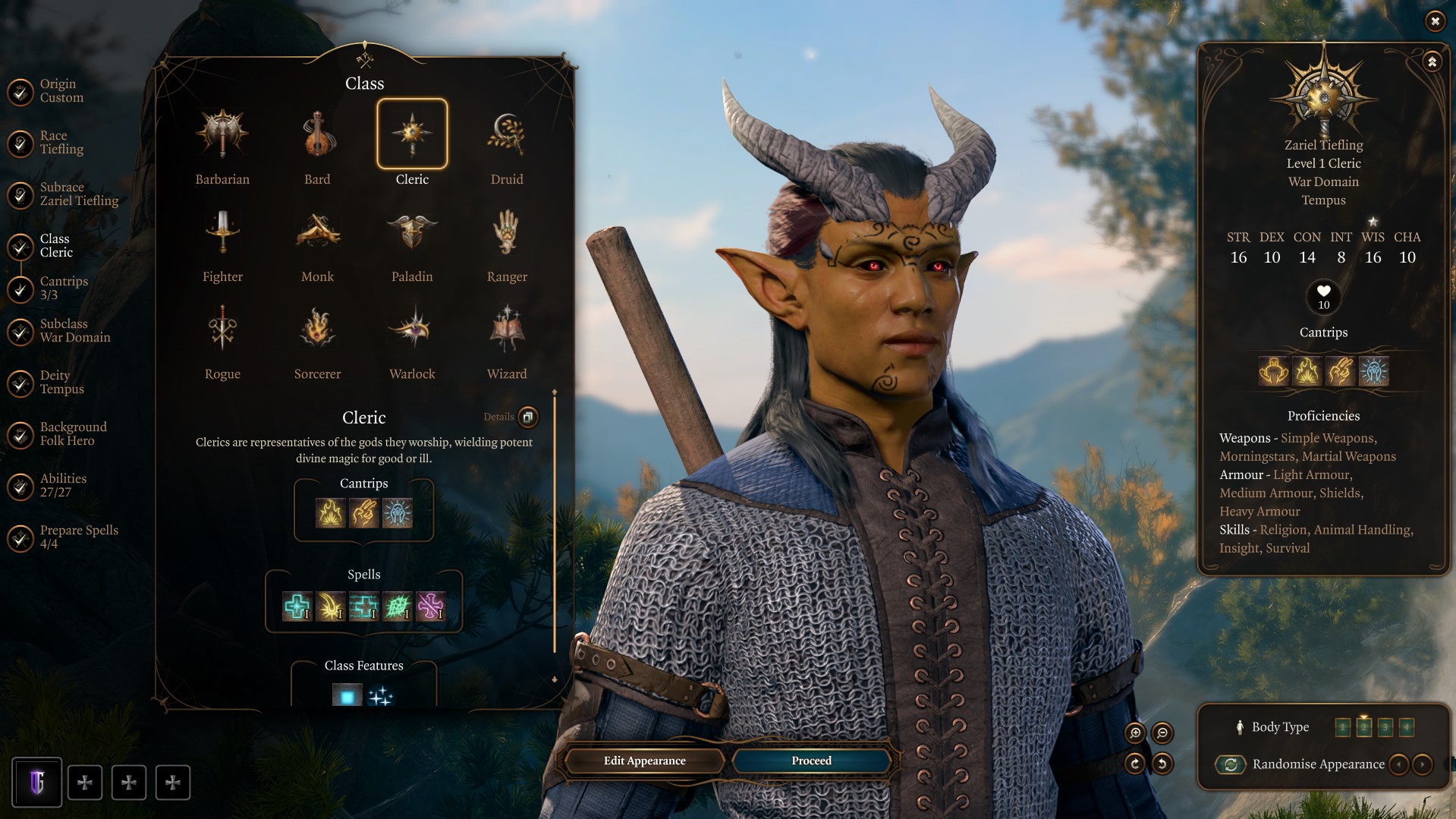
At Level One follow our character creation steps above to pick all correct background, race, skills, and ability score distributions. You want to use heavy armour, along with a one-handed weapon and shield. For Clerics, you’ll be choosing your subclass at level 1, pick the War Cleric subclass. The War Cleric will allow bonus action melee attacks, and we will also be using Paladin Multiclass to pick up Divine Smites and Extra Attack. This will give us three weapon attacks per turn as we advance in each class.
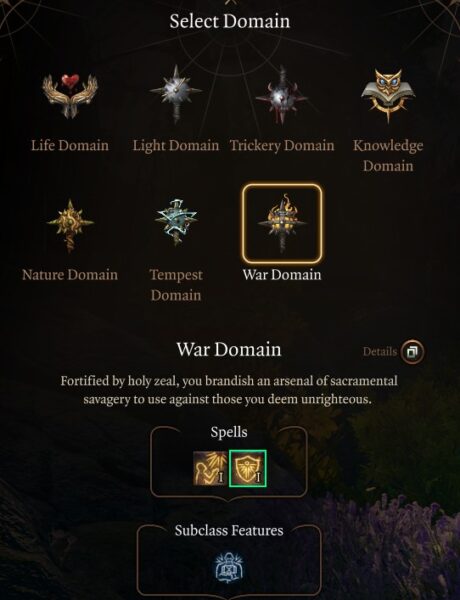
Also at Level One, you will unlock three cantrips and pick three prepared spells. Cantrips are reusable and don’t require a spell slot resource. Prepared spells can be swapped in and out before combat, so use the loadout at the end of the level for a helpful guide. Also, your subclass will provide always prepared “Domain Spells” which will not fill up your prepared slots. Below is our recommendation for level 1 Cleric Multiclass Build:
Cantrips Selection
- Sacred Flame: Conjure a flame-like radiance that deals 1d8 Radiant. This Cantrip acts with a very low damage range ability that can be used without a spell slow.
- Guidance: Bestow guidance upon an ally. They gain a +1d4 bonus to Ability Checks. This spell is critical during dialogue checks and is very useful outside of combat.
- Thaumaturgy: Gain Advantage on Intimidation and Performance Checks. This is another helpful noncombat-related cantrip.
Prepared Spells
- Guiding Bolt: 4d6 Radiant damage that grants Advantage on the next Attack Roll against the target.
- Bless: Up to 3 creatures and they gain a +1d4 bonus to Attack Rolls and Saving Throws.
- Command: Command a creature to flee, move closer, freeze, drop to the ground or drop its weapon.
- Sanctuary: You or an ally cannot be targeted until you attack or harm a creature.
Subclass Features
- Divine Favour (domain spell): Your prayer empowers you with divine radiance. Your weapons deal an additional 1d4 Radiant damage.
- Shield of Faith (domain spell): Surround a creature with a shimmering field of magic that increases its Armour Class by 2.
- Turn Undead: Inflicts Turned. Present your holy symbol and pray. Each undead that can see or hear you is forced to flee from you.
- Guided Strike: Reaction. You gain a +10 bonus to your Attack Roll.
Multiclass Cleric at Level 1
The general premise of the build is to take three levels into Cleric which will give us a lot of spells and utility. Then switching to Paladin for 5 levels to grab Divine Smite and Extra Attack. Then finish up the leveling process to get advanced spells and more subclass passives. This loadout that I’m giving you is geared towards damage with high survival (one hand and shield). You can modify it to have more healing or use a two-handed Greatsword so feel free to adjust. However, this does work for its intention, big damage in melee.
Spell Use on Multiclass Cleric Explained
What you unlock at Level 1 is a lot of spells, cantrips, and subclass features. Bless is a useful concentration spell that will help increase your percentage to land attacks and two other allies. It costs concentration, which means you cannot cast another concentration spell at the same time if you want the effects to hold. Typically this is a good use of your action on turn one when your mobility is lower and you cannot reach the melee range. Gear and the Vengeance subclass will solve the mobility issues.
Next, you have a powerful crowd control spell Command which you can use Grovel to knock prone or Drop to drop their weapon. Even though this is a single-target, lower-level spell, it’s one of the strongest in the game even at later levels. The percentage to land is very high and it can carry you “stuns” early in the game. Guiding Bolt is a very powerful ranged damage ability that can proc Advantage and feed into the Astarion Rogue build sneak attack damage.
Your War subclass unlocks two domain spells which are always prepared. Divine Favour can add radiant damage and also requires concentration. Shield of Faith increases Armour Class (AC) but requires concentration. For this build, Bless has utility for both you and your party and is typically the best use of your concentration spell.
Gameplay at this level is very lackluster mainly because you have very limited spell slots and low mobility. Trust me, both of these issues will be solved, but it’ll take some gear and leveling until it becomes apparent. Rely on Sacred Flame cantrip for ranged damage, Command for a stun, Bless for a buff, and damage with melee weapon attacks.
Multiclass Cleric Gameplay & Priorities
During the early phase of BG3, your Multiclass Cleric should equip a One-Handed weapon and Shield as soon as possible. This will help your defensive potential immensely. Moreover, rely on cantrips for damage when out of spell slots like Sacred Flame. Spell casting can be tough at the start of Baldur’s Gate 3 with limited spell slots. Moreover, look to acquire Elixir of Hill Giant Strength, Potion of Speed, and Oil of Accuracy consumables. These three consumables “stack” allowing for massive damage. These two stack together for a powerful effect early in BG3.
Your overall priority with the Multiclass Cleric build is the following:
- Complete Prologue
- Recruit Other Companions
- Reached Hollowed City/Druid Grove
- Sell, Stock up, complete quest
- Unlock Withers, respec to proper ability score
- Progress to level 5
- Reach Underdark and Grymforge
Following these steps ensures a strong foundation, especially if you plan on playing solo or on Honour Mode difficulty.
Multiclass Cleric Level 2 Prepared Spells: Guiding Bolt, Bless, and Command.
Level 2
The Level 2 Cleric will receive one newly prepared spell and two subclass features. Below is what you unlock and how to use it:
- Healing Word (spell selection): 1d4 Heal a creature you can see up to 18m away with a bonus action. Since this is a bonus action heal, you can combine it with an action-based heal like Cure Wounds or others to do two heals in one turn.
- Turn Undead (subclass feature): Inflicts Turned, each undead that can see or hear you is forced to flee from you.
- Guided Strike (subclass feature): You gain a +10 bonus to your Attack Roll uses reaction.
Multiclass Cleric Gameplay at Level 2
Turn Undead is also a subclass action that can lock down and make the undead run away. Turn Undead has a huge radius and in very specific fights it can affect the enemies significantly if undead. You can examine enemies by right-clicking and hitting examine to make sure they are undead.
Guiding Strike is simply mega-powerful, giving you a +10 to your Attack Roll as a reaction. Reactions can be used in conjunction with actions and bonus actions, spiking your damage through the roof when you need it most. This reaction costs a Channel Divinity Charge which is your Cleric resource and can replenish on short or long rest.
For spell selection, the Healing Word spell is a powerful heal because it requires a bonus action. If you want more healing and support, drop Guiding Bolt for Cure Wounds. You can pair these two together for good healing in one turn, though the focus is still damage.
At this point, we have a lot of utility and a great spell selection to choose from. We are going to swap to Paladin for 5 levels before returning to Cleric. The reason is that we want to quickly gain access to Divine Smite and Extra Attack. This will give us two attacks per action with the ability to trigger extra damage with Divine Smite. Let’s see what’s next with the Best Baldur’s Gate 3 Multiclass Cleric Build!
Multiclass Cleric Level 2 Prepared Spells: Guiding Bolt, Bless, Command, and Healing Word.
Level 3
At Level 3, select the + sign in the upper right of the leveling screen. Select the Paladin class and the Vengeance subclass. Below is what you unlock with 1 level into the Vengeance Paladin:
- Oath of Vengeance Subclass: focuses on hunting down and punishing evil.
- Oath of Vengeance Tenets: Fight the Greater Evil and No Mercy for the Wicked.
- Channeled Oath Charges: Paladin-specific resource that allows the casting of spells and abilities.
- Lay on Hands: Use your blessed touch to heal a creature or cure it of all diseases and poisons.
- Divine Sense: Gain Advantage on Attack Rolls against celestials, fiends, and undead.
- Inquisitor’s Might: You or an ally’s weapon attacks deal an additional 2 Radiant damage and can Daze enemies for 1 turn.
The Vengeance subclass will help aid in mobility and additional useful spells. You must maintain your Oath, AKA meaning not murdering half a village. If you are that type of player (I hope not), you can still use this build with the Oathbreaker subclass. This will only change a few subclass features while maintaining the essential Paladin feel. Read this guide on how to become or remove the Oathbreaker if this happens.
At this level in Paladin, you mainly unlock your resource, a useful heal Lay on Hands, and some buffs. The gameplay is mainly the same, except you have more utility and are not completely reliant on spell slots for healing and utility. Next level it gets much better!
Multiclass Cleric Level 3 Prepared Spells: Guiding Bolt, Bless, Command, and Healing Word.
Level 4
With two levels invested into Paladin, you unlock a lot of features including a Fighting Style and Divine Smite. Here’s what happens at this level:
- Protection Fighting Style: When you have a Shield, impose Disadvantage on an enemy who attacks one of your allies when you are within 1.5 meters.
- Divine Smite (class feature): deals 2d8 Radiant weapon damage and consumes a spell slot.
- Thunderous Smite (spell selection): Your weapon rings with thunder as you strike, pushing your target 3m away and possibly knocking it Prone.
- Cure Wounds (spell selection): Heal a creature you can touch for 4~11 Healing.
- Compelled Duel (spell selection): Compel an enemy to attack only you. It cannot attack other creatures.
Divine Smite is a signature ability of the Paladin class in Baldur’s Gate 3. It allows Paladins to expend a spell slot to deal additional radiant damage to a creature they have hit with a melee weapon attack. The amount of extra damage is equal to 2d8 for a 1st-level spell slot, plus 1d8 for each spell level higher than 1st. The damage increases by 1d8 if the target is an undead or a fiend.
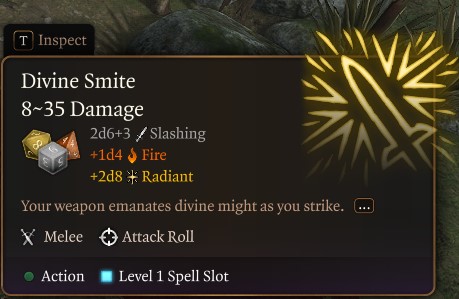
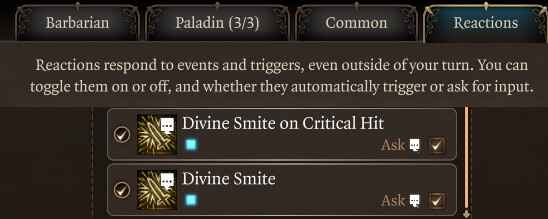
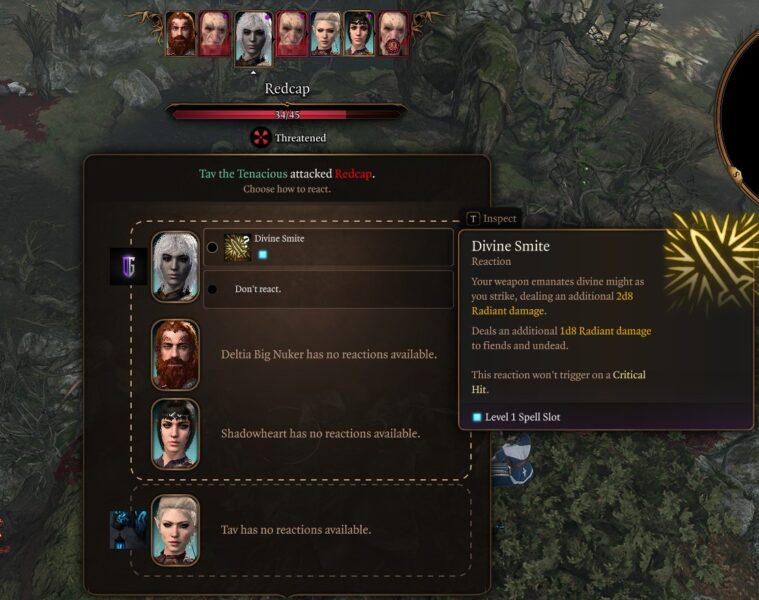
Divine Smite Explained
Divine Smite can be toggled on or off in the reactions menu under the user interface. This allows you to decide whether or not to use it on a given attack. This is important because Paladins can quickly run out of spell slots, limiting their damage output. You don’t want to waste a spell slot on a weak creature. Divine Smite isn’t considered a spell and doesn’t require concentration. It simply adds damage via spell slot resources. This will boost your damage, and you can now still use two attacks with War Cleric. With 5 levels in Paladin, we get Extra Attack, giving us another free attack making it 3 all with the ability to trigger Divine Smite.
The Fighting Style selection assumes you will follow the One Hand and Shield gameplay. You can play two-handed Greatsword instead, and if you do, take the Great Weapon Fighting style instead. Protection will help your survivability significantly retaining the holy warrior Cleric and Paladin combination. For spells, I typically don’t use Smite spells like Thunderous, Searing, and others. These spells cost a spell slot, have an added effect, and consume your action and bonus action as well as cost concentration. All this to say, they are costly with little return for consuming all your resources. They still have usages, but Divine Smite spell slots are typically the play.
Cure Wounds spell selection helps with added support and healing while Compelled Duel can help soft “taunt” a target. This will give them an incentive to target you can help allies. We will continue to stick with the Paladin for the next three levels so let’s see what they have.
Multiclass Cleric Level 4 Prepared Spells: Guiding Bolt, Bless, Command, Healing Word, Thunderous Smite, Cure Wounds, and Compelled Duel.
Level 5
Level 3 into the Paladin unlocks two subclass spells, two subclass actions, and a newly prepared spell.
- Divine Favour (spell selection): Your weapons deal an additional 1d4Damage Radiant damage.
- Bane (subclass spell): Up to 3 creatures receive a -1d4 penalty to Attack Rolls and Saving Throws.
- Hunter’s Mark (subclass spell): Mark a creature as your quarry to deal an additional 1d6 Slashing Damage whenever you hit it with a weapon attack. If the target dies before the spell ends, you can mark a new creature without expanding a spell Slot.
- Abjure Enemy (subclass ability): Frighten an enemy, they’ll be easier to hit and cannot move. Fiends and undead have Disadvantage on this Saving Throw.
- Vow of Enmity (subclass ability): Gain Advantage on Attack Rolls against an enemy.
- Divine Health (subclass feature): prevents the disease from affecting you.
Abjure Enemy and Vow Enmity are not technically spells and consume your Channeled Oath resource, so consider them a utility skill. Bane and Hunter’s Mark are useful spells, but both require concentration, so they become less useful and typically are avoided. Divine Health is a passive feature, and we are one level away from a feat and two from an Extra attack.
Multiclass Cleric Level 5 Prepared Spells: Guiding Bolt, Bless, Command, Healing Word, Thunderous Smite, Cure Wounds, Compelled Duel, and Divine Favour.
Level 6
With four levels into Paladin, you unlock one feat, and one more prepared spell.
- Searing Smite (spell selection): Your Weapon deals an extra 1d6 Fire damage and marks the target with Searing Smite. A target with Searing Smite takes 1d6 Fire damage every turn until it succeeds on a Constitution saving throw.
- Savage Attacker (feat selection): You roll your damage dice twice when making melee weapon attacks and use the highest result.
The critical decision at this level is your feat selection. Savage Attacker is a great choice because of the damage it gives you when you damage an enemy. Strength is also useful via Ability Improvement because it can increase your damage and chance of landing. Ability improvement for Wisdom will aid your Cleric spells and Charisma will only help Paladin spells, not Divine Smite. Typically at this level, I find the Cleric lacking mobility and Initiative.
Alternative Feat Choices
For alternative feats, consider Alert: You gain a +5 bonus to Initiative and can’t be Surprised. This will radically help you from going last in the attack order. The important reason is you can crowd control, kill, or provide support before enemies can attack you. Surprise essentially skips your turn and is a status effect. The reason the attack order is so low is because of lower Dexterity. We have to sacrifice some ability score to pump up Strength and Wisdom and that’s our selection. If you’re frustrated going later in the round and find yourself constantly crowd-controlled, consider Alert.
The Sentinel feat can be useful if playing with another melee damage dealer nearby. Shield Master can be helpful to improve Dexterity saving throws. Consider Heavy Armour Master if you enjoy playing a “tank” build and want to reduce damage. This will give you 1 Strength, which you can reach an even number with our permanent stat guide.
Ending Act 1 as a Multiclass Cleric
Around Level 6 you should be close to transitioning out of Act 1. Be sure to visit vendors and stock up on camp and alchemy supplies. Additionally, make sure to find the best Act 1 items. Furthermore, there are also permanent bonuses you don’t want to miss in Act 1. Finally, the Grymforge has powerful armor and weapons (Adamantine) that can be used well into Act 3. Consider taking the time to collect the crafting items before moving on to Act 2, where you won’t be able to return.
Multiclass Cleric Level 6 Prepared Spells: Guiding Bolt, Bless, Command, Healing Word, Thunderous Smite, Cure Wounds, Compelled Duel, Divine Favour, and Searing Smite.
Related:
Level 7
Level 5 into Paladin unlocks Extra Attack, two subclass spells, and one prepared spell.
- Extra Attack (class feature): Beginning at level, you can attack twice, by the Attack action on your turn.
- Hold Person (subclass spell): Hold a humanoid enemy still. They can’t move, act or react. Attacks from within 3m are always Critical Hits.
- Misty Step (subclass spell): Surrounded by silver mist, you teleport to an unoccupied space you can see.
- Branding Smite (spell selection): deals 2d6 radiant damage and possibly marks your target with light, preventing it from turning Invisible.
Multiclass Cleric Gameplay at Level 7
Extra Attack is the big boost in power giving us two attacks per one action. Combine this with a bonus action attack and Guiding Strike/Divine Strike there is a ton of damage going out per turn. That’s the critical decision you need to make each turn at this point. Attacking, in melee range has more damage than spells considering the Extra Attack and Divine Smite combination. While you still want to use spells for support, crowd control, and damage when you cannot reach, your main goal is melee attacks.
Misty Step spell helps increase our mobility with a bonus action teleport and a big range. Branding Smite is the spells selection and helps increase damage. I use this if I have a bonus action, and it’s my second attack with Extra Attack. You can prevent invisibility which helps in specific fights though not many. Hold Person is a powerful crowd control spell but requires concentration and I find Command is usually better and more reliable.
At this stage, we’ve gotten a huge power boost from the Paladin and we will go back into the Cleric for further spells. Let’s show you what’s next with the Best Baldur’s Gate 3 Multiclass Cleric Build.
Multiclass Cleric Level 7 Prepared Spells: Guiding Bolt, Bless, Command, Healing Word, Thunderous Smite, Cure Wounds, Compelled Duel, Divine Favour, Searing Smite, and Branding Smite.
Level 8

We are done with Paladin levels, so click the large Cleric mace to go back to increasing those levels. Keep in mind, your prepared spells might reset so look before if this happens. We will continue with Cleric for the rest of the leveling process. At this level, we gain two level 3 spell slots and one newly prepared spell.
- Lesser Restoration (spell selection): Cure a creature from disease, poison, paralysis, or blindness.
- Magic Weapon (subclass feature): Infuse a weapon with arcane energy. The weapon becomes magical, receiving a +1 bonus to Attack and Damage Rolls.
- Spiritual Weapon (subclass feature): Summon a floating, spectral weapon that attacks your enemies alongside you for 10 turns
Spiritual Weapon is a powerful summon ability that does not require concentration. Even at higher levels, this is useful for extra damage and a decoy. You can cast it with a bonus action and it’s nice on turn one where usually you are moving into melee range anyway. I typically either do Misty Step, melee attacks, or Spiritual Weapon and Bless. Turn two I go into priority mode which is attacking, crowd control, and healing if desperate.
Magic Weapon is a useful spell to buff our damage passively though it requires concentration. This spell lasts until a long rest, so you can precast if you do not plan on using Bless and save an action when combat starts. Lesser Restoration is a utility spell and consider that a flex spot if you wish to select something else.
Multiclass Cleric Level 8 Prepared Spells: Guiding Bolt, Bless, Command, Healing Word, Thunderous Smite, Cure Wounds, Compelled Duel, Divine Favour, Searing Smite, Branding Smite, and Lesser Restoration.
Level 9
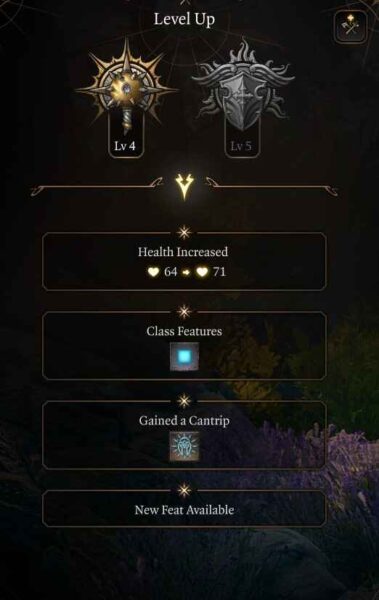
At level 9, with 4 levels into the Cleric, you will unlock one cantrip, one spell, and one feat. Here are our suggestions:
- Light (cantrip selection): Infuse an object with an aura of light. Lasts until Long Rest.
- Silence (spell selection): Create a sound-proof sphere. All within are Silenced and Immune to Thunder damage.
- Ability Improvement (feat selection): Add +2 to Strength.
Another important decision on feats here, in general the +2 to Strength is the safest way to increase power. Alternatives for the feat selection are Alert, or +2 Wisdom if you want to use more Cleric spells rather than melee attacks. This can also be changed at the end game if you have Gauntlets of Hill Giant of Strength. Those Gauntlets will increase your strength to 23 but are acquired much later in Act 3. You can also use potions until a long rest like Elixir of Cloud Giant which increases Strength to 21 until a long rest. The issue with these is, that you will constantly be resting to recover spell slots and quickly run out. When in doubt, +2 Strength is the play.
Multiclass Cleric Level 9 Prepared Spells: Guiding Bolt, Bless, Command, Healing Word, Thunderous Smite, Cure Wounds, Compelled Duel, Divine Favour, Searing Smite, Branding Smite, Lesser Restoration, and Hold Person.
Level 10
Level 5 within the Cleric unlocks two domain spells, one newly prepared spell, and one sublcass feature:
- Mass Healing Word (spell selection): Heal up to 6 creatures for 1d4 + Spellcasting Modifier Hit Points.
- Spirit Guardians (sublcass feature): Call forth spirits to protect the area around you. Nearby enemies take 3 – 24 Radiant damage or 3 – 24 Necrotic damage per turn, and their Movement Speed is halved. On Save: Targets still take half damage.
- Crusader’s Mantle (sublcass feature): Radiate a holy power that emboldens nearby allies. Their weapon attacks deal an additional 1∼4 Radiant damage.
- Destroy Undead (Class feature): When you’ve successfully Turned an undead using Turn Undead, it also takes 4d6 Radiant damage.
The biggest boost to power is Spirit Guardian. Within a 3m radius, enemies take radiant or necrotic damage. Considering this is a heavy melee pressure build, it’s a must-have in our arsenal for passive damage. The downside of this spell is it lasts only 10 turns, and it requires concentration. Thus, you should use it on turn one rather than outside of combat.
For spell selection, Mass Healing Word is a great utility spell for area-based healing. While you don’t want to focus on healing, this can help revive allies back up or save your team from a wipe. Crusader’s Mantle is helpful when playing with another melee damage dealer. Destroy Undead improves the utility of Turn Undead doing big damage when you use that ability. Consider using Spirit Guardian as your main usage of concentration going forward.
Multiclass Cleric Level 10 Prepared Spells: Guiding Bolt, Bless, Command, Healing Word, Thunderous Smite, Cure Wounds, Compelled Duel, Divine Favour, Searing Smite, Branding Smite, Lesser Restoration, Hold Person, and Mass Healing Word.
Level 11
At level 6 into the Cleric you unlock one subclass feature and one prepared spell.
- Glyph of Warding (spell selection): Inscribe a circle of arcane glyphs on the ground that triggers a magical effect when stepped on by an enemy.
- War God’s Blessing (subclass feature): Endow a nearby ally with the glory of your god to grant them a +10 bonus to their Attack Roll.
War God’s Blessing is a great utility if played in combination with another melee damage dealer. Glyph of Warding is a good utility spell that can do some range damage with a given elemental type. This is useful if you cannot reach the fight and need to do area damage.
Multiclass Cleric Level 11 Prepared Spells: Guiding Bolt, Bless, Command, Healing Word, Thunderous Smite, Cure Wounds, Compelled Duel, Divine Favour, Searing Smite, Branding Smite, Lesser Restoration, Hold Person, Mass Healing Word, and Glyph of Warding.
Related:
Level 12
At Level 12, you will have 7 levels into Cleric and 5 levels into Paladin. Once you select your spells, go back into the spellbook and add more. Below are the ones I suggest, but click on Cleric and then Paladin to add additional spells if lacking.
- Guardian of Faith (spell selection): Hostile creatures within a 10-ft radius of the created guardian must succeed on a Dex. save or take 20 radiant damage.
- Banishment (spell selection): Temporarily Banish your target to another plane of existence.
- Protection from Poison (spell selection): Touch a creature to neutralize all poisons affecting it, and grant it protection against poisonous influences. Grants Advantage on Saving Throws against being Poisoned, and grants it Resistance to Poison damage.
- Stoneskin (subclass spell): Turn a creature’s flesh hard as stone. It gains Resistance (half the damage) of all non-magical Bludgeoning, Piercing, and Slashing damage.
- Freedom of Movement (subclass spell): The Target’s movement is unaffected by difficult terrain, spells, or water.
Multiclass Cleric Gameplay at Level 12
Guardian of Faith is a great summon that cannot move but deals damage in a 10-foot radius. Every time it does damage, it takes damage. The nice thing about this spell is it can be used in conjunction with a Spiritual Weapon. One is an action, one a bonus action and BOTH do not require concentration. So, on turn one, you can drop down Guardian in the middle of the action along with Spiritual Weapon.
Banishment is one of the best single-target crowd controls in the game and should be used when the percentage is high. You can temporarily remove a high-damage target for two turns and clear out additional enemies before focusing it down. Stoneskin is a good buff for spellcasters with low AC and Freedom of Movement is a niche spell. Expect some extra utility and power at this level and make sure to check below for gear, armour, and weapon recommendations for the Best Baldur’s Gate 3 Multiclass Cleric Build.
Multiclass Cleric Level 12 Prepared Spells: Guiding Bolt, Bless, Command, Healing Word, Thunderous Smite, Cure Wounds, Compelled Duel, Divine Favour, Searing Smite, Branding Smite, Lesser Restoration, Hold Person, Mass Healing Word, Glyph of Warding, and Guardian of Faith.
Recommended Gear for Baldur’s Gate 3 Multiclass Cleric Build
In Games like Baldur’s Gate 3, you’ll explore the world, loot chests and your enemies’ dead bodies, and complete quests and all those activities can reward you with useful items, potions, armor, weapons, scrolls, and much more. There are three Acts in BG3, and the Best Baldur’s Gate 3 Multiclass Cleric Build includes suggested sets and alternatives for Act 1 and Act 3.
Beginner: Starting the Game
Here’s the best beginner gear for the Best Baldur’s Gate 3 Multiclass Cleric Build:
| Gear Slot | Best Gear Item | Effect |
|---|---|---|
| Head | Haste Helm | Increase Movement |
| Cape | – | |
| Chest | Adamantine Splint Armour | 18 AC |
| Gloves | Hellrider’s Pride | Heals give resistance |
| Boots | Disintegrating Night Walkers | Mobility and Misty Step |
| Necklace | Amulet of Misty Step | Free Misty Step |
| Ring | Ring of Absolute Force | Thunderwave Spell |
| Ring | Crusher’s Ring | Increased Movement |
| Weapon 1 Main Hand | Adamantine Longsword | +1 Longsword |
| Weapon 1 Off-Hand | Glowing Shield | 8 HP when below 50% Health |
Below is the best Act 1 Armor, Weapons, and Equipment for Multiclass Cleric in BG3:
- Haste Helm: Found in Act 1 Blighted Village (X:32, Y:403)(alternative Grymskull Helm).
- Adamantine Splint Armour: Crafted in the Adamantine Forge (alternatives Luminous Armour, or Githyanki Half Plate).
- Hellrider’s Pride: Can be bought, stolen, or earned from Zevolr (alternatives Gloves of Missile Snaring, or Gloves of Hail of Thorns).
- Disintegrating Night Walkers: Can be taken from Nere, at the Grymforge (alternatives Boots of Striding, or Boots of Aid and Comfort
- Amulet of Misty Step: Found in a Gilded Chest (X386 Y8) in a Defiled Temple (alternatives Moondrop Pendant, or Amulet of Restoration).
- Crusher’s Ring: Can be looted or stolen from Crusher in the Goblin camp (alternatives Strange Conduit Ring, or Ring of Absolute Force).
- Ring of Absolute Force: Dropped by Sergeant Thrinn in Grymforge (alternatives The Whispering Promise, or Ring of Colour Spray).
- Adamantine Longsword: Crafted in the Adamantine Forge (X:-137, Y:558) (alternatives Phalar Aluve, or Githyanki Longsword).
- Glowing Shield: In a chest on a slope behind the goblin camp. (X: -54, Y: 462)(alternatives Wood Woad Shield).
Advanced: End-Game
The following table presents the best advanced and end-game gear for the Best Baldur’s Gate 3 Multiclass Cleric Build:
| Gear Slot | Best Gear Item | Effect |
|---|---|---|
| Head | Helm of Balduran | Cannot Be Stunned |
| Cape | Mantle of the Holy Warrior | Free Crusader’s Mantle |
| Chest | Helldusk Armour | 21 AC |
| Gloves | Gauntlets of Hill Giant Strength | 23 Strength |
| Boots | Helldusk Boots | Cannot be Moved |
| Necklace | Amulet of Greater Health | 23 Constitution |
| Ring | Killer’s Sweetheart | Auto Critical |
| Ring | Ring Of Regeneration | Passive healing |
| Weapon 1 Main Hand | The Blood of Lathander | Sunbeam and Healing |
| Weapon 1 Off-Hand | Viconia’s Walking Fortress | 3 AC, Reflect Spell |
Below is the best Act 3 Armor, Weapons, and Equipment for Multiclass Cleric in BG3:
- Helm of Balduran: Found on an altar next to Ansur in The Wyrmway, Act 3. (Alternative Helldusk Helmet).
- Mantle of the Holy Warrior: Sold by Vicar Humbletoes in Stormshore Tabernacle (Alternative Cloak of the Weave, or Cloak of Protection).
- Helldusk Armour: Looted from Raphael in the House of Hope (Alternative Armour of Persistence).
- Gauntlets of Hill Giant Strength: Obtained in Archive of the House of Hope (alternatives Helldusk Gloves, or Gloves of Soul Catching).
- Helldusk Boots: Chest on the top floor of Wyrm’s Rock Fortress (Alternative Disintegrating Night Walkers).
- Amulet of Greater Health: Archive in the House of Hope (Alternative Amulet of the Devout, or Spellcrux Amulet).
- Killer’s Sweetheart: Obtained from the Gauntlet of Shar in Act 2 (Alternative Ring of Protection, Risky Ring).
- Ring Of Regeneration: Sold by Rolan at Sorcerous Sundries (Alternative Ring of Free Action, Shifting Corpus Ring).
- The Blood of Lathander: The Blood of Lathander quest in Act 2 (Alternative Selûne’s Spear of Night).
- Viconia’s Walking Fortress: Looted from Viconia DeVir during Shadowheart’s companion quest in Act 3 (Alternative Shield of Devotion).
Consumables, Potions, and Items
Consumables are items that can be used once and then destroyed. They are typically used to restore health or other resources. Some common types of consumables include potions, scrolls, food, drinks, and arrows.
The following list represents the best individual use consumable items that will aid in the Best Baldur’s Gate 3 Multiclass Cleric Build:
- Elixir of Hill Giant Strength: Increases Strength ability score to 21 until Long Rest.
- Elixir of Peerless Focus: gain advantage on concentration saves (ingredients Sublimate of Belladona, and any ashes).
- Potion of Speed: Gain extra action, +2 AC, Advantage on Dexterity Saving Throws, and double movement speed.
- Drow Poison: Weapon poison that adds Constitution Saving Throw or becomes Poisoned and falls Asleep.
- Potion of Flying: Drink to gain a flying speed of 60ft for one hour.
- Elixir of Heroism: Gain 10 temp HP and become Blessed until a long rest.
- Potion of Greater Healing: 4d4 + 4 hit points restored.
- Oil of Accuracy: Coat Weapon. Bonus of +2 in Attack Rolls.
- Elixir of Vigilance: Drink to gain a +5 bonus to Initiative and you can’t be Surprised.
- Elixir of Darkvision: (only non-Darkvision race): Drink to gain the ability to see in the dark up to 12m.
Permanent Bonuses
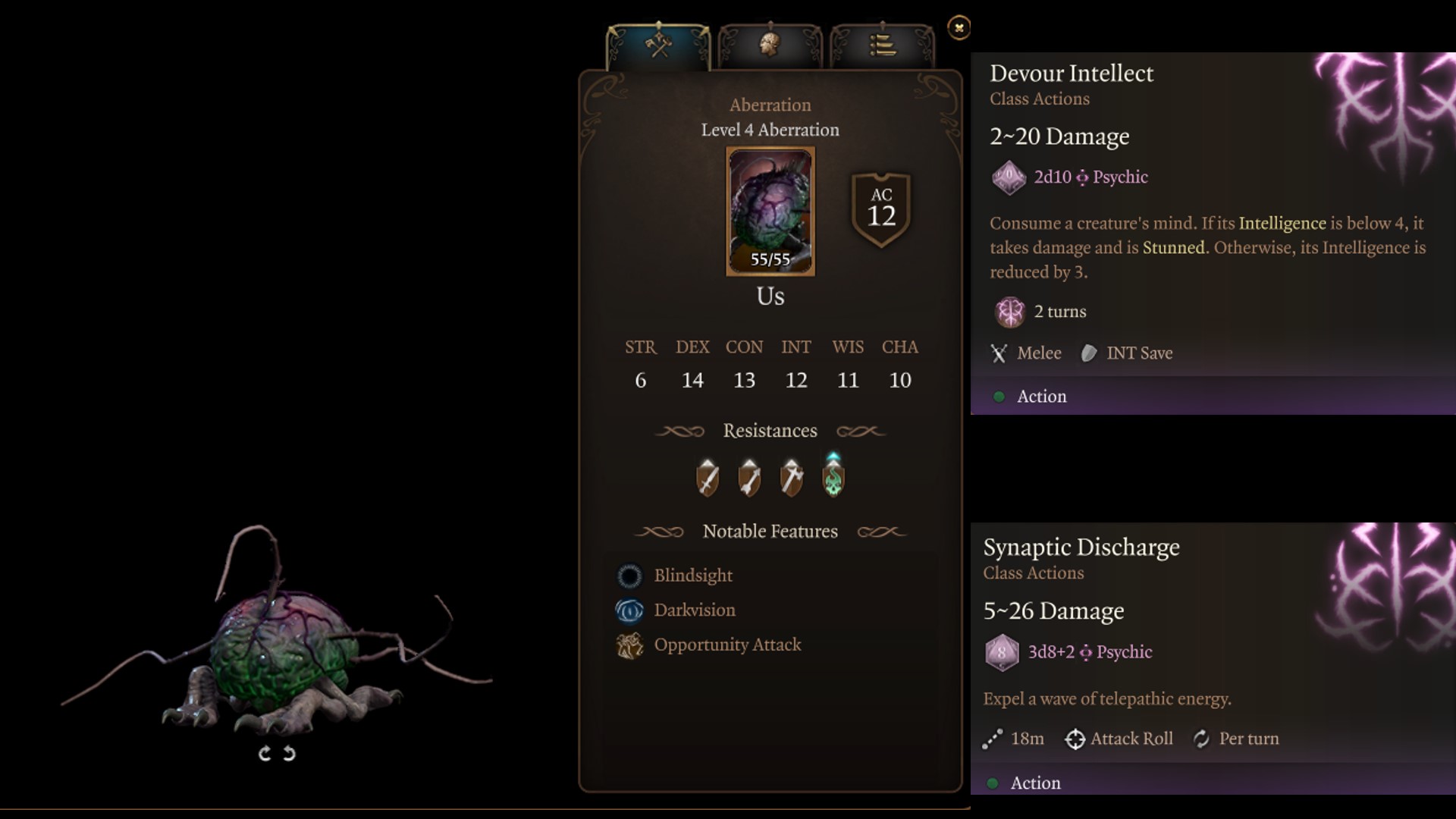
Throughout Baldur’s Gate 3, you will have the ability to gain permanent bonuses to your character. These can grant additional spells, ability scores, and other bonuses. Permanent Bonuses are not displayed throughout the campaign but are vital to increase overall combat performance. We have all permanent bonuses here in a guide, but the most important ones for you to collect are listed below.
| Act 1 | Act 2 | Act 3 |
|---|---|---|
| Auntie Ethel’s Hair: Gain +1 to an Ability Score. | Potion of Everlasting Vigour: Gain +2 Strength. | Mirror of Loss – +2 to an Ability Score of your choice. |
| Awakened: Use illithid powers as a Bonus Action. | Slayer Form: Ability to transform into the Slayer. | Partial Ceremorphosis: Access to tier 3 illithid Powers. |
| Scratch: Gain Find Familiar Scratch. | Summon Us: Allows you to summon Us. | Sweet Stone Features: Blessed permanent. |
| Cheeky Quasit: Gain Summon Quasit Shovel. | Statue of the Gods: +2 to Saving Throws | |
| Loviatar’s Love: 30% Hit Points or less, you gain a +2 bonus to Attack Rolls and Wisdom saving throws. | ||
| Necromancy Of Thay: access to powerful spells in Act 3. | ||
| Volo’s Ersatz Eye: See Invisibility |
Multiclass Cleric Changes in Patch 7 for BG3
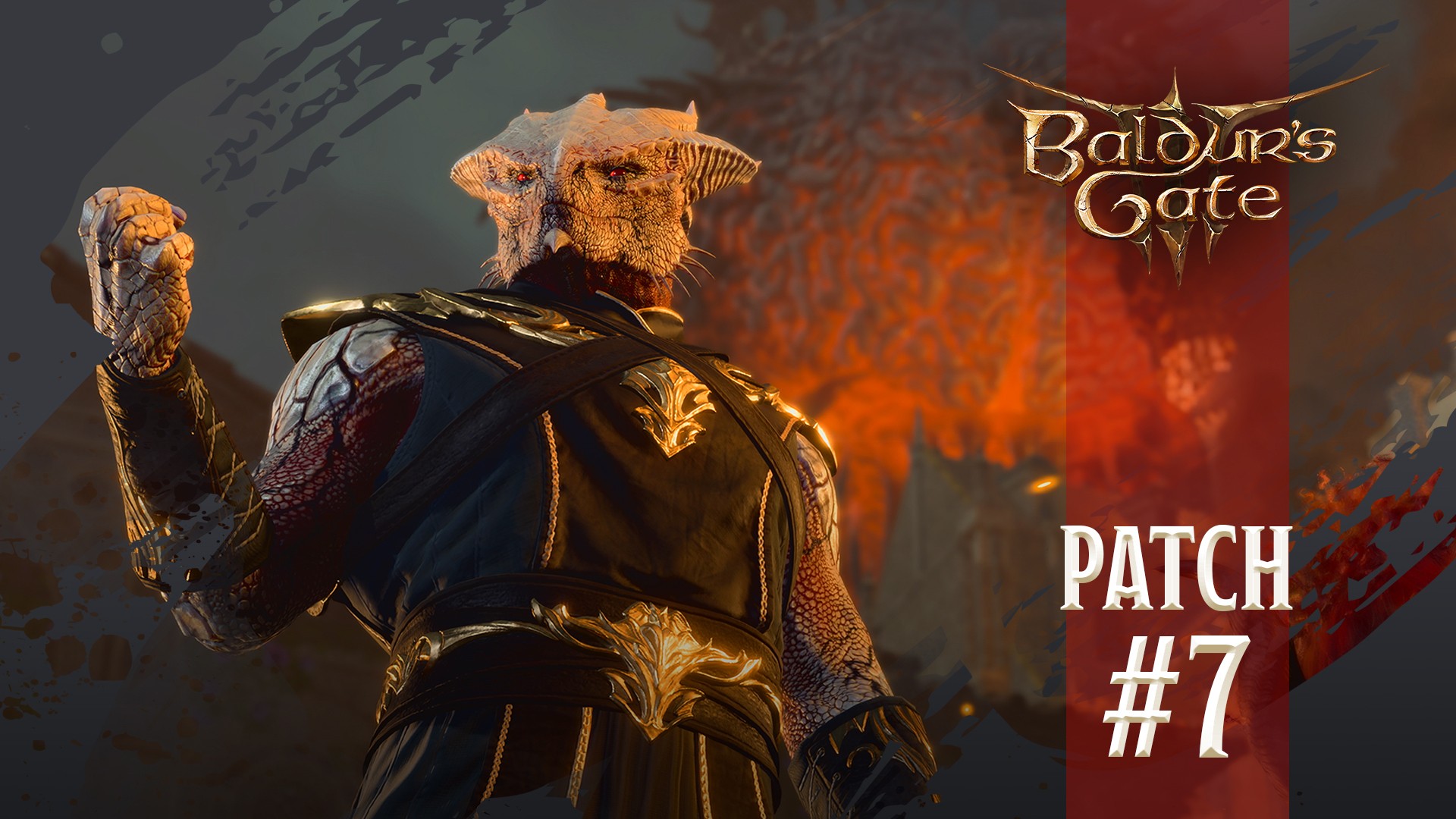
The arrival of Patch 7 for Baldur’s Gate 3 has brought no major balance changes to the game. Most builds, combat, and gameplay elements remained untouched, so if you are familiar with the class, almost all remain the same.
Larian Studios’ main focus in this patch is mods. The game now features a modding toolkit and an in-game mod manager, allowing players to create and install mods directly within the game. Furthermore, Patch 7 also includes several new cinematics and endings for evil characters. Therefore, this best Cleric Build Guide remains unchanged, mainly in Baldur’s Gate 3 Patch 7.
Best Baldur’s Gate 3 Multiclass Cleric Build Guide Summary
- War Domain (Cleric)
- Oath of Vengeance (Paladin)
Armor: Heavy Armour
Weapon: Longsword
Background: Folk Hero
- Strength – 16
- Dexterity – 10
- Constitution – 14
- Intelligence – 8
- Wisdom – 16
- Charisma – 10
Level Progression
- Level 1 – War Domain Cleric
- Level 2 – Guided Strike
- Level 3 – Oath of Vengeance Paladin
- Level 4 – Protection Fighting Style
- Level 5 – Divine Favour
- Level 6 – Savage Attacker Feat
- Level 7 – Branding Smite
- Level 8 – War Domain Cleric
- Level 9 – Feat +2 Strength
- Level 10 – Spirit Guardians
- Level 11 – War God’s Blessing
- Level 12 – Guardian of Faith
Looking For More About Baldur’s Gate 3?
Thank you for reading Best Baldur’s Gate 3 Multiclass Cleric Build Guide. We provide the latest news and create guides for Baldur’s Gate 3. Also, watch me play games on Twitch or visit my YouTube channel!
 Reddit
Reddit
 Email
Email

